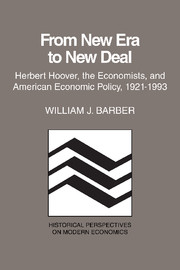Book contents
- Frontmatter
- Contents
- Preface
- Prologue: The vision of a new era in the 1920s
- 1 The ingredients of a model of a new economics
- 2 Challenges to the new economics of the 1920s
- 3 The new economics at center stage in 1929
- 4 Activating the stabilization model in late 1929 and 1930
- 5 Preliminary readings of the results of the stabilization strategy
- 6 The unraveling of the first official model in 1931
- 7 Shifting course in late 1931 and early 1932
- 8 Renewing the offensive in February and March 1932
- 9 The economists and their views on policy for 1932
- 10 Official model II as shaped in May 1932 and the aftermath
- Epilogue: Transition to the New Deal – continuities and discontinuities
- Notes
- Selected bibliography
- Index
1 - The ingredients of a model of a new economics
Published online by Cambridge University Press: 19 October 2009
- Frontmatter
- Contents
- Preface
- Prologue: The vision of a new era in the 1920s
- 1 The ingredients of a model of a new economics
- 2 Challenges to the new economics of the 1920s
- 3 The new economics at center stage in 1929
- 4 Activating the stabilization model in late 1929 and 1930
- 5 Preliminary readings of the results of the stabilization strategy
- 6 The unraveling of the first official model in 1931
- 7 Shifting course in late 1931 and early 1932
- 8 Renewing the offensive in February and March 1932
- 9 The economists and their views on policy for 1932
- 10 Official model II as shaped in May 1932 and the aftermath
- Epilogue: Transition to the New Deal – continuities and discontinuities
- Notes
- Selected bibliography
- Index
Summary
By the standards now applied by the editors of professional journals, the model of the economy worked out in the 1920s by Hoover and his associates would be judged to be deficient in rigor. It was not presented in technical language and was totally innocent of mathematical notation. Nor did it develop an explicit distinction between what would later be identified as macroeconomics, on the one hand, and microeconomics, on the other; that was to be an innovation of another time. Nevertheless, the doctrine of the Hooverites spoke to the issues to which economic theorists have long attended: the analysis of production and exchange, of the distribution of income, of the problems of economic stability and growth, and of the nature of international trade and investment. Not only did those who envisioned the emergence of a new age in the 1920s offer an account of the way these aspects of economic activity related to one another, they also posed the further question of how the observed functioning of the economy could be improved. Economics for them, as for Keynes, was “a dangerous science” in that part of its purpose was to challenge accepted patterns of thought and action.
Hoover had set out his views on the objectives of economic policy before he began his duties at the Commerce Department. In November 1920, in his capacity as president of the newly formed American Engineering Council, he commissioned an investigation into waste in industry.
- Type
- Chapter
- Information
- From New Era to New DealHerbert Hoover, the Economists, and American Economic Policy, 1921–1933, pp. 7 - 41Publisher: Cambridge University PressPrint publication year: 1985
- 1
- Cited by

